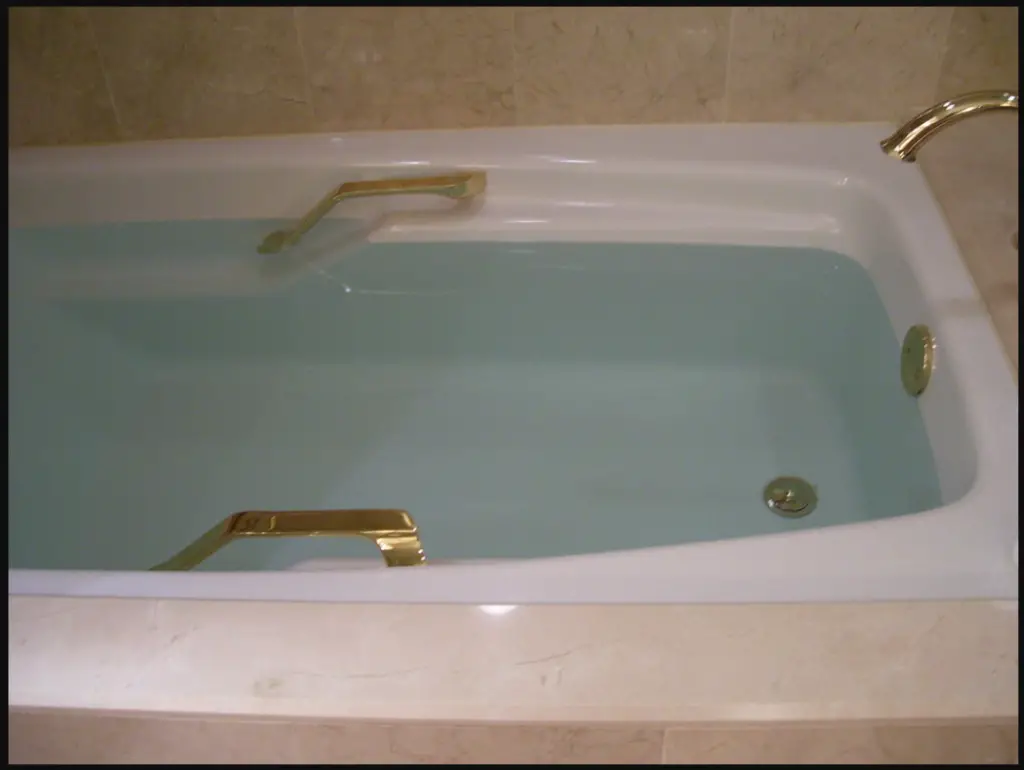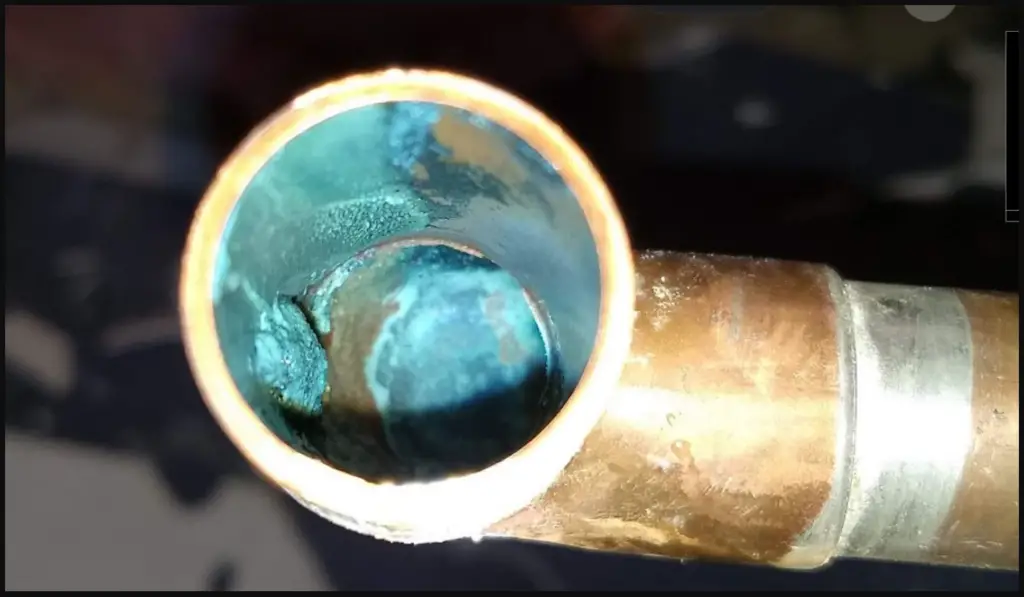Why Is My Bath Water Blue? Fully Explained
This is a very common problem that I’ve heard about in my life as a plumber because most people have no idea why their bath water is slightly blue in color, and they want to know whether it is harmful or not and find ways to fix it.
So in this article, I’ll discuss what causes this bluish bath water, its safety, and possible methods to get it fixed ASAP. If you have any other related problems, feel free to leave a comment in the comment box. Welcome to PlumbInsight.
Table of Contents
Why is my bath water blue?
Your bath water turns blue because of copper reacting with oxygen, creating a bluish-green color. This color might stick to your skin and clothes while bathing. Small amounts of copper are usually safe, but too much can be harmful, causing nausea and other issues.

Copper can come from corroded pipes or private wells. To fix it, test your water for copper levels and, if it is too high, consider a water filtration system or alternative methods for a safer bath.
However, other causes could include the use of bath products like bath bombs or salts containing color additives. These products, when dissolved in water, release vibrant hues. If you haven’t used copper pipes and the blue tint persists, consider whether any recent bath products might be contributing to the color change.
How does the copper mix with my bath water?
Copper mixes with your bath water primarily through a process called corrosion. In homes with copper pipes, water flowing through these pipes can cause a gradual breakdown of the copper material. This breakdown, or corrosion, releases small amounts of copper into the water.
As water travels through the pipes, it reacts with the copper, especially when exposed to oxygen. This reaction forms copper ions, and in the presence of certain conditions, such as changes in temperature or water chemistry, these ions can dissolve into the water. Consequently, the dissolved copper gives your bath water a bluish tint.
Corroded pipes are the most common source of copper in water, and this phenomenon is more prevalent in older plumbing systems. It’s essential to note that public water supplies typically monitor and regulate copper levels to ensure they remain within safe limits, but private wells might lack such oversight, potentially leading to higher copper concentrations.
Dealing with Low Thermopile Voltage in Your Water Heater: Causes and Solutions Explained
PLUMBINSIGHT.COM
Is blue bath water safe?
While a bluish tint in bath water is often harmless, it may indicate the presence of copper. In small amounts, copper is generally safe, but excessive levels can be toxic, leading to nausea, diarrhea, and more severe health issues.
If your water is consistently blue, it’s advisable to test for copper levels. If within safe limits, there’s likely no cause for concern. However, if levels are high, it could pose health risks.
How to fix blue bath water problem?
If you’re dealing with persistently blue bath water, the culprit is likely copper. To remedy this issue, follow a systematic approach:
1. Water Testing
Begin by testing your water for copper levels. Water testing kits are widely available and clearly indicate whether elevated copper is causing the discoloration.
2. Install a Water Filtration System:
If the test reveals heightened copper levels, consider installing a water filtration system. There are effective options for whole-house systems, countertop filters, under-sink filters, and faucet-mounted filters. These systems use physical barriers, chemical processes, or biological processes to remove impurities such as copper.
3. Explore Alternative Methods
Look into alternative methods for copper removal. Reverse osmosis, ion exchange, activated carbon filters, and water softeners are all options. Each method approaches the problem differently, so select one that meets your water quality requirements.
4. Professional Plumbing Inspection
If the problem persists, hire a plumber to inspect your plumbing system. Corroded pipes may be contributing to the presence of copper, which a plumber can assess and replace if necessary.
By systematically following these steps, you can effectively eliminate excess copper from your bath water, ensuring a safe and clear bathing experience.

Why are my shower walls and sinks blue?
If your shower walls and sinks are turning blue, it is likely due to the presence of copper in the water. The blue coloration occurs when copper, often originating from corroded pipes, reacts with oxygen. This chemical reaction forms copper ions, and when they come into contact with surfaces, they can leave behind a bluish tint.
The process is similar to what happens in bath water, and it’s a clear indication that there may be elevated copper levels in your water supply. Besides the potential aesthetic concerns, it’s essential to address this issue to ensure the safety of your water and prevent any long-term damage to plumbing fixtures.
How to clean blue shower heads and sinks?
Cleaning blue stains from shower heads and sinks caused by copper in the water can be tackled with a few simple steps:
01. White Vinegar Solution
- Mix equal parts white vinegar and water in a bowl.
- Soak a cloth or sponge in the solution.
- Wipe down the affected surfaces, allowing the vinegar to break down and lift the blue stains.
02. Baking Soda Paste
- Make a paste using baking soda and water.
- Apply the paste to the stained areas.
- Allow it to sit for 15-20 minutes, then scrub with a soft brush or sponge.
- Rinse thoroughly.
03. Lemon and Salt Scrub
- Cut a lemon in half.
- Dip the cut side in table salt.
- Scrub the stained areas with the lemon/salt combination.
- Rinse well to remove residue.
04. Commercial Cleaners
- Consider using commercial cleaners designed for removing stains from bathroom fixtures.
- Follow the product instructions carefully.
Always check cleaning product compatibility with your specific fixtures, and test on a small, inconspicuous area first to ensure it doesn’t damage the surface. Regular cleaning and addressing the underlying water issue will help keep your shower heads and sinks free from persistent blue stains.
Rheem vs. AO Smith Water Softener; Complete Comparison
PLUMBINSIGHT.COM
Why is my bath water green?
Same as blue water, if your bath water is green, the most likely culprit is the presence of copper. Copper can react with elements in the water, such as oxygen, leading to the formation of copper compounds that impart a greenish hue. This reaction is more noticeable in standing water, like in a bathtub.
The green color in your bath water is generally considered safe in small amounts. However, if the water appears excessively green, it may indicate elevated copper levels, which can be a cause for concern. Testing your water for copper levels is a good first step.
If the levels are higher than recommended, you might want to consider installing a water filtration system to address the issue and ensure your bath water is safe and clear.
Why is my bath water yellow?
Yellow bath water can have various causes, and identifying the reason may help address the issue. Here are a few potential explanations:
- Dissolved Minerals: High levels of minerals like iron or manganese in the water can cause it to appear yellow. These minerals can come from the water source or corroded pipes.
- Sediment Buildup: Sediment or rust particles in old or deteriorating pipes can give the water a yellow tint.
- Tannins in Well Water: If your water comes from a well, yellow discoloration may be due to tannins, organic substances that leach into the water from decaying vegetation.
- Water Treatment Products: Certain chemicals or water treatment products, if not used correctly, might contribute to discoloration.
To address yellow bath water:
- Water Testing: Conduct a water test to determine the specific cause of the discoloration.
- Pipe Inspection: If the issue is related to corroded pipes or sediment buildup, consider having your plumbing inspected and possibly replaced.
- Water Filtration: Install a water filtration system designed to address the specific impurities causing the discoloration.
Understanding the source of the yellow tint will guide you in taking the appropriate steps to ensure your bath water is clear and safe. If you’re unsure, consulting with a water quality professional or plumber can provide valuable insights.





